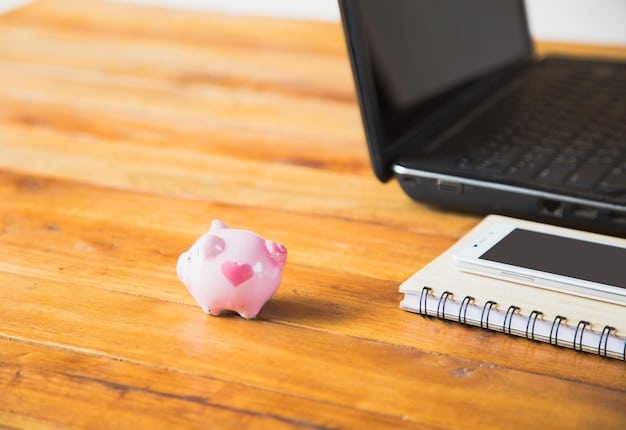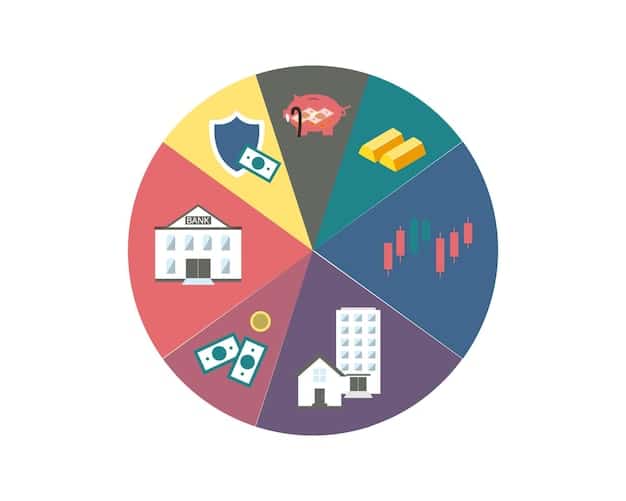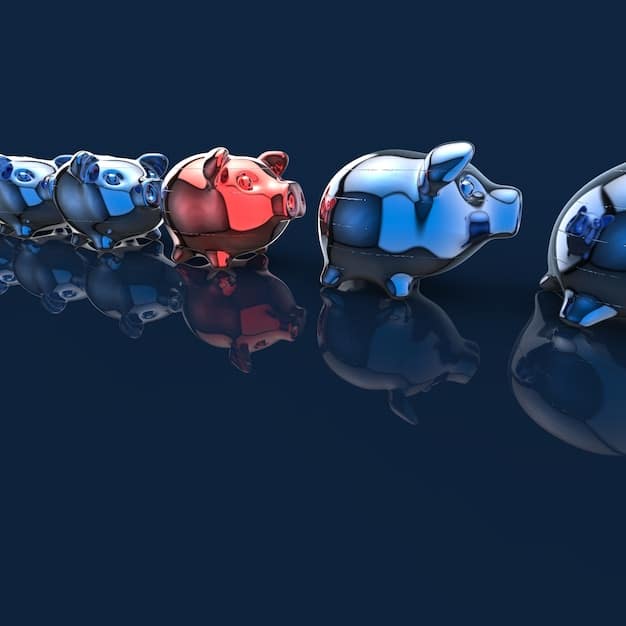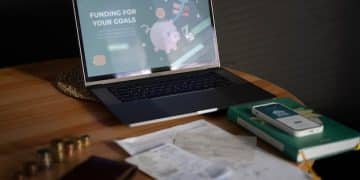Build a Freelance Emergency Fund: Protect Your Income

A freelance emergency fund is crucial for financial stability, offering a safety net to cover unexpected expenses and income fluctuations, ensuring peace of mind and business continuity.
As a freelancer, your income can fluctuate, and unexpected expenses can arise at any time. Building a freelance emergency fund: How to Build a Safety Net to Protect Your Income and Peace of Mind is a crucial step to protect your finances and ensure peace of mind.
Why Freelancers Need an Emergency Fund
Freelancing offers flexibility and autonomy, but it also comes with financial instability. Unlike traditional employment, freelancers often lack benefits like paid sick leave or employer-sponsored retirement plans. This makes having an emergency fund even more critical.
An emergency fund acts as a financial cushion, giving you the ability to handle unforeseen circumstances without derailing your business or personal finances. Here’s why it’s paramount for freelancers:
Income Fluctuations
Freelance income can vary significantly from month to month. Some months you may have more work than you can handle, while others might be surprisingly slow. An emergency fund allows you to bridge the gap during lean periods, ensuring you can still cover essential expenses.
Unexpected Expenses
As a freelancer, you’re also responsible for covering expenses that an employer would typically handle. This could include equipment repairs, software upgrades, taxes, or healthcare costs. An emergency fund ensures you can address these expenses without going into debt.
- Covers Living Expenses: Ensures rent, utilities, and food are covered during income dips.
- Handles Medical Bills: Provides funds for unexpected healthcare costs.
- Business Continuity: Allows you to invest in your business, even during slow periods.

In short, a dedicated emergency fund is an absolute necessity for any freelancer who’s serious about their long-term financial well-being and stability.
How Much Should You Save?
Determining the right amount to save in your emergency fund is a crucial step. While there’s no one-size-fits-all answer, aiming for three to six months’ worth of living expenses is a common guideline. However, you might adjust this based on your unique circumstances and risk tolerance.
To calculate your target number, start by tracking your monthly expenses. Include everything from rent or mortgage payments to groceries, utilities, transportation, and debt payments.
Calculate Monthly Expenses
Add up all your essential monthly costs. This will give you a baseline figure for what you need to cover each month.
Assess Income Stability
If your income is highly variable, or if you work in a competitive industry, consider saving closer to six months’ worth of expenses. If your income is more stable, three months may be sufficient.
- 3-6 Months Coverage: The generally recommended range.
- Assess Income Stability: Variables such as industry changes can require extra saving.
- Factor in Business Costs: Include business-related expenses in your total.
Ultimately, the amount you save is a deeply personal decision. Saving even a smaller amount can still provide peace of mind and a financial buffer against unexpected events. Don’t be afraid to start small and gradually increase your savings over time.
Opening a dedicated account
Once you’ve determined how much to save, the next step is choosing the right place to store your emergency fund. Keeping it separate from your everyday checking account helps ensure you won’t accidentally spend it, and that it’s readily available when needed.
Several types of accounts can be suitable for an emergency fund, each with its own pros and cons. High-yield savings accounts and money market accounts are popular choices due to their accessibility and potential for earning interest.
High-Yield Savings Accounts
These accounts offer higher interest rates compared to traditional savings accounts, allowing your money to grow faster while remaining easily accessible. They’re typically FDIC-insured, providing an additional layer of security.
Money Market Accounts
Money market accounts are similar to savings accounts but may offer slightly higher interest rates and additional features like check-writing privileges. However, they may also have higher minimum balance requirements.

- Liquidity: Ensure funds are easily accessible without penalties.
- Interest Rates: Look for competitive rates to maximize growth.
- FDIC Insurance: Opt for accounts insured by the FDIC for security.
Consider comparing interest rates, fees, and accessibility when choosing an account for your emergency fund. Online banks often offer higher interest rates than traditional brick-and-mortar banks, as they have lower overhead costs.
Strategies for Building Your Fund Quickly
Saving three to six months’ worth of expenses can seem daunting, especially when you’re starting from scratch. But don’t get discouraged! There are several strategies you can use to accelerate your savings and build your emergency fund more quickly.
Start by setting a realistic savings goal and breaking it down into smaller, more manageable steps. Automate your savings by scheduling regular transfers from your checking account to your emergency fund. Even small, consistent contributions can add up over time.
Automate Savings
Set up automatic transfers from your checking to your savings account each month. This “set it and forget it” approach makes saving effortless.
Reduce Expenses
Identify areas where you can cut back on spending. Even small reductions can free up extra cash to put towards your emergency fund.
- Track Expenses: Understand where your money is going.
- Set Savings Goals: Break down the larger total into smaller, measurable targets.
- Seek Additional Income Streams: Complement earnings to boost the fund consistently.
Another effective strategy is to put any “extra” money, such as tax refunds, bonuses, or freelance windfalls, directly into your emergency fund. You can also try the “50/30/20” rule, which allocates 50% of your income to needs, 30% to wants, and 20% to savings and debt repayment.
Maintaining and Replenishing Your Fund
Building an emergency fund is an ongoing process, not a one-time event. Once you’ve reached your initial savings goal, it’s important to maintain and replenish your fund as needed. This ensures that it remains a reliable safety net for years to come.
Regularly review your emergency fund to ensure it still covers your current living expenses. As your income and expenses change, you may need to adjust your savings goal accordingly. Additionally, be mindful of inflation, which can erode the purchasing power of your savings over time.
Regular Reviews
Periodically assess and refine your fund to keep up with shifts in income.
Avoid Dipping Into It
Try to avoid using your emergency fund for non-emergency expenses.
- Budgeting Discipline: Protect your fund through careful planning.
- Savings Discipline: Keep contributing even after meeting fund targets.
- Restoring the Fund: Focus on replenishing the fund if it’s been used.
If you do need to tap into your emergency fund, make it a priority to replenish it as soon as possible. Treat it as a bill that needs to be paid, and set up a repayment plan to get your savings back on track.
Common Mistakes to Avoid
Building and maintaining an emergency fund can be challenging, and it’s easy to make mistakes along the way. Recognizing these common pitfalls can help you stay on track and avoid derailing your progress.
One common mistake is delaying saving for an emergency until you feel like you can afford it. The truth is, there’s never a “perfect” time to start saving. Even small contributions can make a big difference over time. Another mistake is using your emergency fund for non-emergency expenses, such as vacations or impulse purchases.
Procrastination
Delaying starting is a common mistake which can be avoided by starting with small and manageable amounts.
Misusing Funds
Using the fund for non-emergencies defeats its very purpose. Reserve it strictly for genuine crises.
- Inadequate Savings: Not saving enough to cover expenses.
- Ignoring Business Expenses: Failing to include business-related costs.
- Not Replenishing: Failing to restore the fund after it’s been used.
Finally, don’t get discouraged if you experience setbacks or unexpected expenses. Building an emergency fund is a marathon, not a sprint. Stay focused on your long-term goals, and celebrate your progress along the way.
| Key Point | Brief Description |
|---|---|
| 💰 Start Saving | Begin saving small amounts consistently to build your fund over time. |
| 📊 Calculate Needs | Determine 3-6 months of essential living expenses for your financial safety net. |
| 🛡️ Dedicated Account | Keep the emergency fund in a separate, accessible, and high-yield savings account. |
| 🔄 Replenish | Prioritize restoring any used funds to maintain a stable financial cushion. |
FAQ Section
The standard recommendation is to save three to six months’ worth of living expenses. However, individual circumstances may require more or less, depending on financial stability and personal comfort.
It’s best to keep your emergency fund in a high-yield savings account or a money market account. These accounts offer liquidity and some interest, helping your money grow while still being accessible.
Automate savings, reduce unnecessary expenses, and allocate any extra income, such as tax refunds or freelance bonuses, directly into the emergency fund. Consistent savings will steadily grow your fund.
Generally, it’s best to reserve your emergency fund for true emergencies like unexpected health issues or sudden income loss. Business investments should come from separate funds allocated for such purposes.
If you use part of your emergency fund, prioritize replenishing it as soon as possible. Create a budget to allocate funds specifically for rebuilding your savings until it’s fully restored.
Conclusion
Building a freelance emergency fund is an investment in your financial stability and peace of mind. By following these steps, you can create a safety net that protects you from life’s unexpected challenges, allowing you to thrive as a freelancer.





